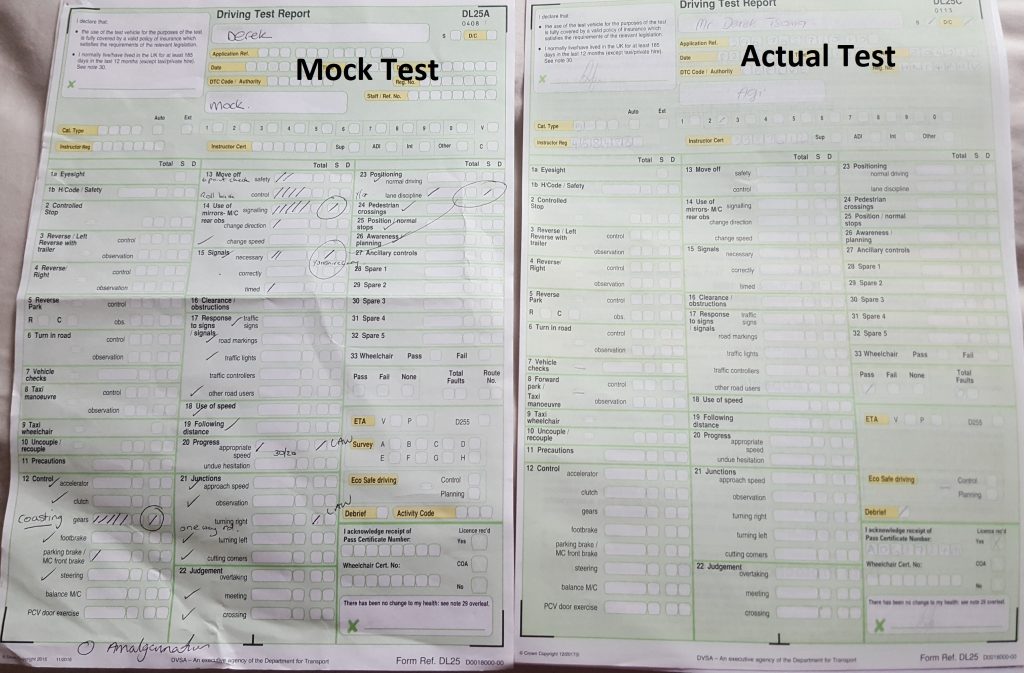Now that Cara is getting older, I’d like to have the option of taking her to places beyond London. As an Aussie Expat who has held a full Australian driver’s licence since the early 2000s, you might be wondering what the heck does Derek know about the UK Theory and Practical Driving test? Well, unfortunately I forgot to transfer my Australian licence across to the UK version, even when the DVLA are kind enough to give you 5 years to do so.
Exchanging Licences
The first tip is to exchange your licence across to the UK version as soon as you have been at a permanent address in Great Britain for more than 185 days. It will save you the hassle of going through the entire learner’s process again, including the driving test. It will also work out cheaper as it only costs £43 to exchange it.
To check if you’re eligible to exchange your licence, please check here. You should be eligible if hold a licence from the EU, Northern Ireland, Channel Islands, or a ‘designated country’: Andorra, Australia, Barbados, British Virgin Islands, Canada, Falkland Islands, Faroe Islands, Gibraltar, Hong Kong, Japan, Monaco, New Zealand, Republic of Korea, Singapore, South Africa, Switzerland and Zimbabwe.
If you do qualify, then order the D1 form from the DVLA site here.
Theory & Hazard Perception Test
50 multiple choice questions in 57 minutes followed by 14 hazard perception clips can be daunting. However, with so many free apps available these days, there’s no excuse for not trying to understand the basics and practising tests. If you’re super worried, you can opt to purchase the official DVLA test kit for under £15 online.
Although I’ve had previous driving experience from Oz, the UK road rules and regulations are slightly different. Yes, we have the same Stop and Give Way signs, but there’s a lot more differences than there are similarities. Personally, I downloaded two free apps off Google Store and spent most of my spare time going through the practice tests. Where I answered incorrectly, I read the correct response and reasoning behind it to ensure I understood it to minimise the chances of getting it incorrect again. If you Google ‘hazard perception test’, you’ll find a myriad of sites that offer free examples of the hazard perception test, so please use them to become familiar with what to expect. Like any exam, practice is key to ensure you are confident on the day.
After about 3 months of on and off practising, I set myself a goal of passing the theory before the end of 2017 and decided to book the theory test just before Christmas 2017 as I had time off work. Walking into the test centre, a quick check of the Provisional licence and you’re ushered into a room full of computers where you click away for your driving career. Depending on how confident you are, you could be finished within half an hour or so. But remember, it’s not a race and you have more than enough time to review each question and answer.
Top 5 Theory & Hazard Perception Test Tips
- Access as much content as possible to assist with your studies – e.g. free or paid apps, websites
- Practice the tests – it was amazing to see how some of the questions on the actual test were the same as on the free apps
- Ensure you’re well rested and relaxed on test day. Your brain can recall more information if you are
- Arrive early to the test centre to check in and settle to the surroundings. You don’t want to be rushed and stressed.
- Be positive and picture yourself walking out of the test centre with a Pass result
Practical Test
What’s more daunting than clicking answers on a computer monitor? Perhaps a 40 minute driving test with a stranger that will determine if you can drive or not?
Pre-Test
After passing the theory test, I started looking online for a local instructor to help with the driving test. I decided to go with 1st Time School of Motoring as the reviews, prices and availability all lined up. From driving in Oz for close to 10 years and during holidays in Europe and the US, I considered myself to be a fairly confident driver. However, that first lesson was something else. Having a stranger judging your skills with a mock driving test is quite nerve-racking.
I appreciate that new learners will start right from the beginning such as the biting point, clutch control, and braking. So it’s unlikely that you’ll be driving straightaway. Based on statistics, it takes an average of 40 hours of driving before a learner is ready for the test.
Being based in South-East London, there’s lots of buses, roundabouts, traffic control measures, and tight streets where cars are parked on both sides to navigate. Practising the manoeuvres took a lesson, but my main weakness was trying to break the bad habits I had developed over the years. Habits such as coasting, rollbacks, not observing sufficiently and the occasional speeding were difficult to unlearn. You don’t realise how slow 20mph is until you are actually travelling at that speed. Through the course of eight lessons, instructor Steve (legend) was able to help and remind me each week of what to focus on.
I set myself another goal of obtaining my Driver’s Licence by the end of Q1 2018. Steve confirmed I was ready for the driving test. Due to availability, I booked at Belvedere DVSA test centre in March. I did not realise it was the ‘most failed’ centre back in 2014/15 because of its variable speed limits, hilly streets, and difficult roundabouts. Although slightly concerned, I was confident in my abilities. A few days before the driving test, I watched YouTube clips for some final tips and recited the ‘Show me, Tell me’ responses.
Test Day
Test day involved a quick lesson and last minute tips from Steve. My examiner was great and made it as relaxed as possible. If you are nervous, try to spark up a conversation during the initial introductions. Given my previous driving history and lessons, the driving test itself was fairly straightforward. I recall my test in Australia when I was 17 years old and very nervous. Although I passed, the examiner said I was on the border of driving too slow for the road and conditions.
On this occasion, I had to navigate a few roundabouts, tight streets giving way to other vehicles, a forward bay park, a 50mph A-road, hill-start and a few pull up and drive off again. My independent drive was without the Sat-Nav, following road signs. Before I knew it I was back at the test centre.
Remember that you’re allowed up to 15 minor faults (no serious or dangerous faults allowed). Also, the test only stops once the examiner tells you to switch the engine off, after which they will provide the results. It is recommended the instructor listens in case it’s a fail. This is to help work on and correct any faults for next time.
Luckily for me, I passed with zero faults. It was a big difference to my first mock driving test with Steve where I had numerous minor faults and a few serious faults. The weight and pressure was off and I am now legally allowed back on UK roads again!
Top 10 Practical Driving Test Tips
- Make sure you have your eyes tested if you haven’t had one recently, as you’ll need to pass one before driving
- Practice, practice and practice some more – either with a qualified instructor or patient family/friend
- Aim to drive around where you’ve booked your test so you become familiar with the roads. If unable to, Google Map the area
- Be honest with yourself. If you’re not comfortable with a particular manoeuvre, ask for help and keep practising
- Access online content – e.g. YouTube clips such as ‘Learn-to-Drive Travis’ and ‘Advance Driving School’
- Learn the responses to the ‘Show Me, Tell Me’ questions – a quick Google Search provides ample study material
- Remember to constantly observe – check mirrors, blind-spots, road signs and markings
- Ensure you’re well rested and be confident. You’ve already put in the hours so an extra 40 minutes driving around will be a breeze
- Don’t give up! Even if you think you’ve incurred a fault, remain calm and keep driving sensibly. It may have just been a minor.
- Be positive and picture yourself with that Pass Certificate, driving your own car!
Best of luck to all new drivers! Be sure to add your tips or experiences in the comments below.


Nice blog Derek – when I did my test several years ago, the independent driving section tested your reaction to the random situations that came up, and not your navigation etc skills… you couldn’t be failed for missing a turning as long as you were driving safely… knowing this put me significantly more at ease – I know the driving test changed a bit recently, with less focus on manoeuvres and more on the independent driving, but I wonder if it is still the case that you can’t be failed for going the wrong way (safely).
Thanks Tom! Yes, you’re right. If you miss a turn or go the wrong way, it’s not necessarily a fail as long as it’s done safely. Depending on your examiner, it may just be a minor fault for ‘Junctions’ or ‘Response to signs/signals’. The SatNat or examiner will then guide you back on route. Similar to the ‘Show Me/Tell Me’ questions, where answering it incorrectly is a minor fault. So the key thing is to remain calm and carry on.